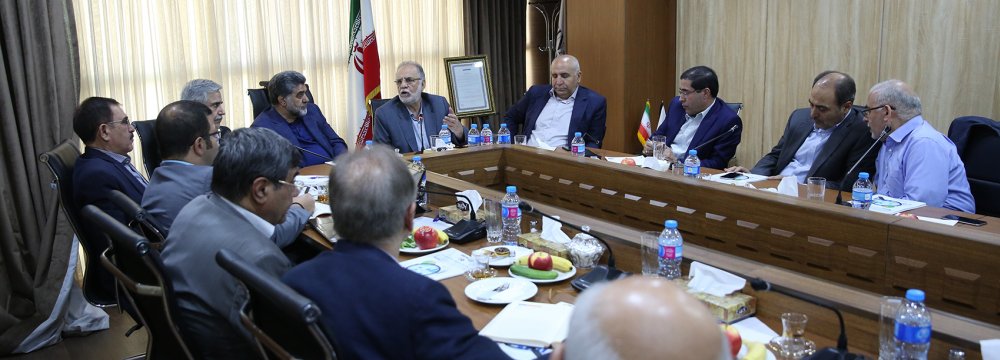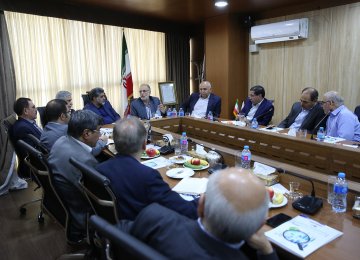Iranian government officials and steel industry players met at Financial Tribune’s office in Tehran on Sunday to set the agenda and the general outlook for the Eighth Iranian Steel Market Conference, otherwise known as ISMC 2018, which is scheduled to be held in the Iranian capital on Jan. 30-31.
The prestigious annual event is hosted by Donya-e-Eqtesad Taban Company, the parent company of Financial Tribune.
Officials who attended the Sunday meeting included the head of Iranian Mines and Mining Industries Development and Renovation Organization, Mehdi Karbasian; Advisor to First Vice President Mostafa Moazenzadeh; Deputy Minister of Industries, Mining and Trade Jafar Sarqeyni; the head of Iran National Development Fund, Ahmad Doust-Hosseini; chief executive of Iran Mercantile Exchange Hamed Soltani-Nejad; Managing Director of Mobarakeh Steel Company Bahram Sobhani; Managing Director of Golgohar Mining and Industrial Complex Nasser Taghizadeh; and CEO of Chadormalu Mining and Industrial Complex Mahmoud Nourian.
Last year’s notable foreign attendants at ISMC included Managing Director of Spain’s Sarralle Group Javier Esquiroz; CEO of Italy’s Danieli Group Gianpietro Benedetti; the head of Germany’s SMS Group, Burkhard Dahmen; CEO of Austria’s INTECO, Harald Holzgruber; and Turkish Steel Exporters Association’s market analyst, Cihan
The tentative themes suggested by Donya-e-Eqtesad's team for the 2018 event included:
- Balanced development of iron ore and steel industry production chain up to 2025
- Moving toward production of high-quality steel with a focus on exports
- Addressing roadblocks to financing the steel industry
- Analyzing factors affecting final prices and streamlining them, and
- Discussing opportunities arising from and challenges to the industry's privatization.
Multifaceted Complications
The Iranian steel industry is a descendant of some of the first nationalization attempts in the country after the 1979 Islamic Revolution. It was built up as a fledgling industry through governmental support, up until the point that it was supposed to steer in a different direction when the country’s large-scale privatization program kick-started in the last decade.
The Iranian government’s heavy footprint in the industry's management has come repeatedly under fire by economists and market players. The privatization program was supposed to make the industry and market independent decision-makers, but with most of the shares ending up in non-private organizations, things barely changed. Decisions are still dictated from above, usually against what the market thinks is best.
Accordingly, the bold role of state in the industry usually prevents industry players, especially the smaller, private producers, to have a say in the decision-making process. This is what makes meetings and events such as the Sunday meeting rare opportunities for the industry to highlight and address its shortcomings.
Iran is planning to become the world’s sixth largest steelmaker by 2025, by securing a 55-million-ton crude steelmaking capacity as per the 20-Year Vision Plan. About 60% of the target have been met, but steel usage is not growing accordingly.
“Based on our calculations, Iran’s steel usage will be less than 30 million tons by 2025. Therefore, we have to export the rest. Now that we are facing so many tribulations for exporting the current 3 million tons, how would things be if it reaches 20-25 million tons,” said Bahram Sobhani, who is the CEO of Iran’s largest steelmaker Mobarakeh Steel.
By tribulations, Sobhani was pointing to the limitations posed by the government on exports to prioritize local demand.
MSC, which was the country’s largest steel exporter two years ago, shipped a total of 1.55 million tons in the last fiscal year (March 2016-17), down 13% compared to the year before. The downtrend has continued into this year, with MSC having been outperformed by its own subsidiary Hormozgan Steel Company in exports. The parent company shipped 365,099 tons during five months (March 21-Aug. 22), down 63% year-on-year. This is while local sales are steadily increasing.
“Export is a costly, lengthy process. We can’t just invest on a country’s consumers for years and then suddenly stop selling to them. We have to look toward markets beyond ourselves,” he said.
Sobhani also criticized the 2025 steel plan over its perceived lack of product diversity and its unnecessary focus on semis. He emphasized that there will be no overseas demand for billet and rebar in the near future, and called for creating extra flat steel capacity to boost the industry’s competitiveness.
Head of NDFI Ahmad Doust-Hosseini also echoed similar remarks, noting that the steel industry will grow and benefit from free market policies.
“Whoever creates any sort of value-added has ownership rights to the material and the government must not dictate any policies by violating that right,” he said.
Iranian mills exported 2.13 million tons of semis and 414,000 tons of finished steel products during this year’s first four months (March 21-July 22), registering a 67% growth and 52% decline YOY.
Production for the period also stood at 7.06 and 6.33 million tons of semis and finished products, up 17% and 10% respectively, according to data by Iran Steel Producers Association.







Add new comment
Read our comment policy before posting your viewpoints